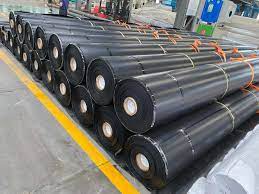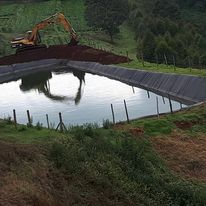When managing aging geomembrane landfill barrier systems, the decision to rehabilitate or replace these crucial components is a pivotal one that requires careful consideration. Geomembrane barriers play a vital role in waste containment and environmental protection within landfills. In this article, we delve into the complexities of assessing aging geomembrane barrier systems, exploring the factors that influence the decision-making process between rehabilitation and replacement. By examining the cost-benefit analysis, environmental impact assessment, and best practices for decision-making in geomembrane barrier system management, we aim to provide valuable insights for professionals in the field.
# 1. Introduction to Geomembrane Landfill Barrier Systems
## Overview of Geomembrane Landfill Barrier Systems
Picture this – your trash is like a rebellious teenager, constantly trying to escape and wreak havoc. Geomembrane landfill barrier systems act as the responsible parent, keeping everything in check.
## Importance of Barrier Systems in Landfill Management
These barrier systems are the unsung heroes of landfill management, preventing toxic waste from seeping into the environment like a bad secret from a leaky bag. They keep our surroundings safe and pristine.
# 2. Assessment of Aging Geomembrane Barrier Systems
## Physical Inspection and Condition Assessment
Just like how a doctor checks your vitals, aging geomembrane barriers need a thorough inspection to ensure they’re still in tip-top shape. No one wants a landfill barrier throwing a tantrum.
## Performance Evaluation and Monitoring
Monitoring these barriers is like keeping an eye on a mischievous child – you need to make sure they’re behaving and doing their job properly. No slacking off allowed!
# 3. Factors Influencing the Decision to Rehabilitate or Replace
## Age and Service Life of the Geomembrane Barrier
Think of the geomembrane barrier’s age like a fine wine – it gets better with time, but eventually, it might turn vinegary. Knowing when to swap it out is key to maintaining a functional system.
## Extent of Damage and Degradation
Nobody likes a barrier system that’s falling apart faster than a cheap umbrella in a storm. Assessing the damage helps decide if it just needs a little TLC or a complete overhaul.
## Regulatory Compliance and Safety Considerations
Regulatory compliance is like following the rules at a family gathering – it’s necessary for everyone’s safety and happiness. Making sure your barrier system meets these standards is crucial.

# 4. Rehabilitation Strategies for Aging Geomembrane Barrier Systems
## Potential Rehabilitation Techniques
From a facelift to a full-blown makeover, there are various techniques to revive an aging geomembrane barrier. Think of it as giving your barrier system a spa day.
## Cost and Time Considerations for Rehabilitation
Rehabilitation isn’t just about making things look pretty – it also needs to make financial sense. Balancing cost and time considerations ensures your barrier system gets the care it needs without breaking the bank.
5. Considerations for Replacement of Geomembrane Barrier Systems
Signs Indicating the Need for Replacement
When your geomembrane barrier system starts resembling a piece of Swiss cheese more than a reliable barrier, it might be time for a replacement. Signs like extensive tears, punctures, or deterioration indicate it’s time to bid adieu to your old geomembrane.
Selection of New Geomembrane Materials
Choosing new geomembrane materials is like picking a new outfit – you want something sturdy, stylish, and suitable for the occasion. Consider factors like material thickness, flexibility, and resistance to environmental factors when selecting your new geomembrane. Remember, it’s not just about looks; it’s about performance.
6. Cost-Benefit Analysis for Rehabilitation vs. Replacement
Calculating Costs of Rehabilitation
Before you jump into rehabilitating your geomembrane barrier system, crunch the numbers like a mathematician on a mission. Calculate costs of materials, labor, and potential downtime to determine if rehabilitation is a budget-friendly option.
Comparing Costs of Rehabilitation and Replacement
Put your Sherlock Holmes hat on and investigate the costs of rehabilitation versus replacement. Sometimes a new geomembrane might be more cost-effective in the long run than constantly patching up the old one. It’s all about finding that sweet spot where quality meets affordability.
7. Environmental Impact Assessment of Rehabilitation vs. Replacement
Environmental Concerns in Rehabilitation Projects
When it comes to rehabilitating your geomembrane barrier system, don’t turn a blind eye to environmental concerns. Ensure proper disposal of old materials, minimize pollution during construction, and follow eco-friendly practices to keep Mother Nature smiling.
Sustainability Aspects of Replacement Options
Considering replacement? Think green and explore sustainable geomembrane options. Look for materials that are recyclable, energy-efficient, and have minimal impact on the environment. It’s not just about protecting your landfill; it’s about protecting the planet.
8. Best Practices for Decision-Making in Geomembrane Barrier System Management
Risk Assessment and Mitigation Strategies
Decisions, decisions! Conduct thorough risk assessments and develop mitigation strategies to navigate the maze of geomembrane barrier system management. Identify potential risks, plan for contingencies, and steer clear of geomembrane disasters like a savvy captain.
Long-Term Maintenance Planning
Just like maintaining a healthy diet, long-term maintenance planning for your geomembrane barrier system is key to its longevity. Schedule regular inspections, address issues promptly, and have a maintenance plan in place to keep your geomembrane in top-notch condition. Remember, a stitch in time saves nine – or rather, a patch in time saves your geomembrane!In conclusion, the decision to rehabilitate or replace aging geomembrane landfill barrier systems is a multifaceted process that requires a thorough understanding of the system’s condition, cost implications, and environmental impacts. By following best practices and considering all relevant factors, landfill operators and environmental engineers can make informed decisions to ensure the continued effectiveness and integrity of these critical barrier systems. As technology advances and sustainability becomes increasingly important, careful management and maintenance of geomembrane barriers will remain essential in safeguarding our environment for future generations.
FAQs
1. How can I determine whether my geomembrane barrier system needs rehabilitation or replacement?
If you’re wondering whether your geomembrane barrier system needs some work, there are a few key factors to consider. First, take a look at the age of the system – if it’s been in place for more than 20-30 years, it may be time for some updates. Next, assess any visible signs of damage such as tears, punctures, or deterioration in the material. If you notice any leaks or seepage coming through the barrier, this is a clear indicator that it’s not working properly and needs attention. Additionally, changes in the area surrounding the barrier such as increased settlement or shifting could indicate that the barrier is failing and requires rehabilitation or replacement. Regular inspections and monitoring of your geomembrane system can help you catch any issues early on and prevent costly repairs down the line.
2. What are the key cost considerations when deciding between rehabilitating and replacing an aging geomembrane barrier system?
When faced with the decision of whether to rehabilitate or replace an aging geothermal system, there are several key cost considerations to take into account. First and foremost, you’ll need to consider the upfront cost of each option. Rehabilitating a system may initially be cheaper than replacing it, but be sure to factor in potential future maintenance costs that may arise from keeping an older system running. Replacement may require a larger initial investment, but it could save you money in the long run by reducing energy consumption and repair expenses. Additionally, think about the cost of downtime during the transition period and weigh that against the benefits of an upgraded system. Ultimately, it’s important to evaluate both short-term and long-term costs before making a decision on whether to rehab or replace your aging geothermal system.
3. Are there specific environmental factors to consider when choosing between rehabilitation and replacement of geomembrane barriers?
When choosing between rehabilitation and replacement of a structure, there are several specific environmental factors that must be considered. Firstly, the impact on local ecosystems should be evaluated to determine the potential harm to wildlife habitats and biodiversity. Additionally, the use of resources such as water, energy, and raw materials should be taken into account in order to minimize environmental degradation. Climate change considerations must also play a role in decision-making, as structures need to be resilient in the face of increasing extreme weather events. Furthermore, carbon footprint calculations can help determine which option is more environmentally friendly in terms of greenhouse gas emissions. Overall, a comprehensive environmental assessment is crucial when deciding between rehabilitation and replacement to ensure the sustainable long-term use of our built environment.
4. What are some common best practices for managing and maintaining geomembrane landfill barrier systems to prolong their lifespan?
In the management and maintenance of geomembrane landfill barrier systems, several best practices are crucial for ensuring their effectiveness and longevity. Regular inspections, both visual and physical, should be conducted to identify any signs of damage or degradation such as tears, punctures, or wrinkles. Proper installation techniques must be followed to prevent wrinkles and ensure adequate overlap at seams. Proper surface preparation, including the removal of sharp objects and rocks, is essential to prevent punctures in the geomembrane. Adequate slope design and proper drainage systems are key components in managing stress on the geomembrane, preventing ponding of water that can lead to deterioration. Additionally, diligent record-keeping of maintenance activities and inspection reports is essential for tracking the performance of the system over time and identifying any patterns or trends that may require corrective action. Overall, proactive monitoring and maintenance practices will help minimize risks associated with geomembrane landfill barriers while ensuring their long-term functionality.
Originally posted 2024-07-13 13:41:21.

